For many book enthusiasts, their home is a reflection of their love for reading. Decorating with books is a great way to add a personal touch to your space, making it feel more inviting and cozy.
Styling with books can be a fun and creative process. It’s not just about stacking them on a shelf; it’s about creating a visually appealing display that showcases your favorite titles and adds to the ambiance of your home.
Whether you’re a seasoned book collector or just starting to build your library, there are many ways to incorporate books into your decor. From modern minimalist designs to vintage-inspired displays, the possibilities are endless.
Key Takeaways
- Use books as decorative elements to add a personal touch to your home.
- Create a visually appealing display by arranging books in a creative way.
- Mix and match different book sizes and colors to add visual interest.
- Consider using book stands or bookends to add a decorative touch.
- Don’t be afraid to experiment and try out different styling ideas.
The Art of Decorating with Books
Books are not just literary companions but also versatile decorative elements that can enhance the aesthetic appeal of any room.
Decorating with books allows you to showcase your personal style while maintaining a functional library. The key is to strike a balance between form and function, making your bookshelves not just repositories of knowledge but also visually appealing displays.
Why Books Make Perfect Decorative Elements
Books can act as art pieces, adding texture, color, and depth to your decor. According to design experts, a well-curated bookshelf can become a focal point in a room, drawing the eye and sparking conversation.
| Decorative Aspect | Functional Aspect |
|---|---|
| Aesthetic appeal through cover design and color | Provides access to a wide range of literature |
| Creates a personal and cozy atmosphere | Serves as a knowledge repository |
| Can be arranged to create visual interest | Allows for easy browsing and discovery |
Balancing Function and Aesthetics in Bookish Decor
To achieve a harmonious balance, consider mixing book orientations, incorporating decorative objects, and varying the height of your book stacks. This approach not only adds visual interest but also keeps the display engaging and dynamic.
Tips for effective book decor include categorizing books by size, color, or genre, and using bookends or decorative items to add personality to your shelves.
Assessing Your Book Collection for Decorative Potential
Transforming your book collection into a decorative element starts with a thorough assessment. To create a visually appealing display, you need to understand the composition of your collection. This involves evaluating the size, color, and genre of your books, as well as their condition and relevance to your decor.
Categorizing Books by Size, Color, and Genre
Categorizing your books is a crucial step in creating a cohesive display. You can group them by size for a uniform look, by color to match your room’s palette, or by genre to tell a story. As noted by interior design experts, “Color-coding your bookshelves can add a pop of color and create a visually appealing display.”
“A well-organized bookshelf is not just about functionality; it’s also about aesthetics.”
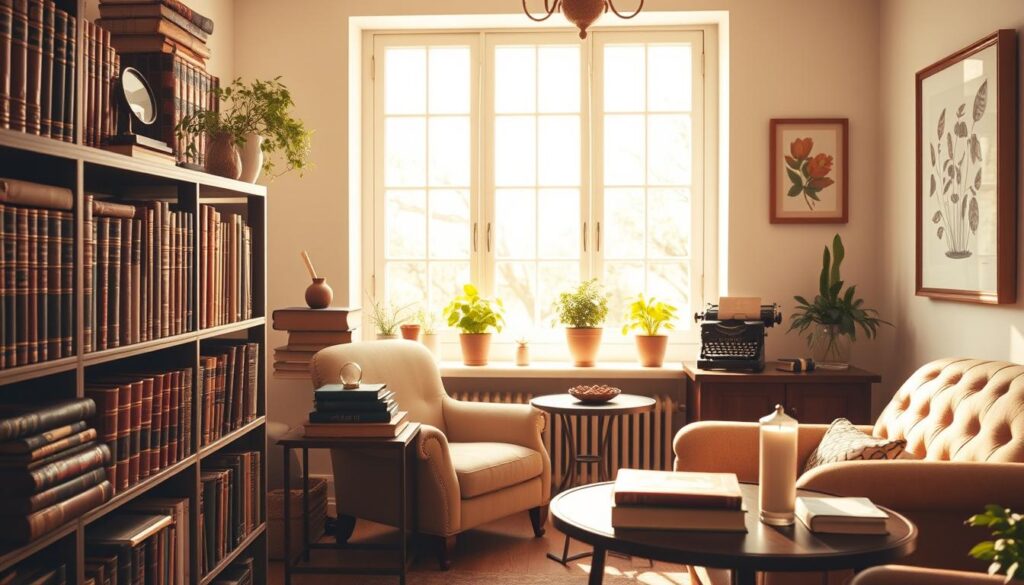
Deciding Which Books to Display and Which to Store
Not all books need to be on display. Decide which ones are worth showcasing based on their cover design, significance, or how well they fit into your decor theme. Consider storing less decorative or worn-out books. For book lovers, this is an opportunity to curate a collection that reflects their personal style.
Working with Both Hardcovers and Paperbacks
Mixing hardcovers and paperbacks can add texture and variety to your book display. Hardcovers can provide a sturdy base, while paperbacks can fill gaps and add layers. For a cohesive look, consider aligning the spines or creating a pattern with the different types of covers.
Bookshelf Organization Strategies
Organizing your bookshelf is not just about keeping your books tidy; it’s an art form that can elevate the entire room. A thoughtfully arranged bookshelf can become a focal point in your home, reflecting your personality and style.
Traditional vs. Creative Shelving Methods
Traditional shelving methods often involve arranging books by author or title, while creative approaches might include organizing by color or size. Creative shelving methods can add a visually appealing element to your decor.
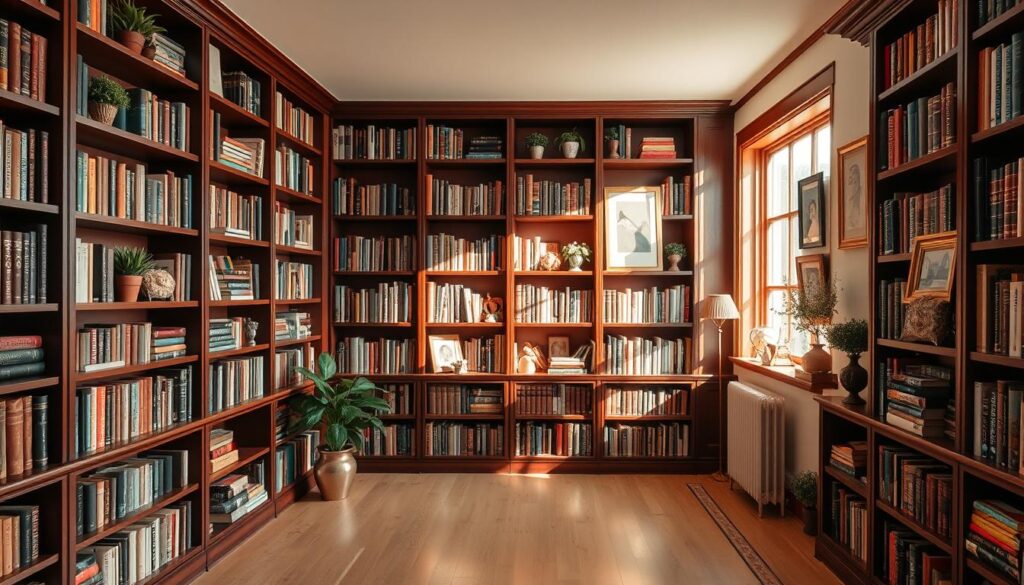
Subject-Based Organization That Looks Stylish
Organizing your books by subject can create a cohesive and stylish display. For example, grouping books on art, design, or history together can create a visually appealing and thematic arrangement.
Mixing Personal and Decorative Books Effectively
Mixing personal and decorative books can add depth and character to your bookshelf. Consider combining your favorite novels with decorative coffee table books or vintage volumes to create a unique display.
| Organization Method | Description | Aesthetic Impact |
|---|---|---|
| Traditional | Organized by author or title | Classic and straightforward |
| Creative | Organized by color or size | Visually striking and unique |
| Subject-Based | Grouped by subject matter | Cohesive and thematic |
By implementing these bookshelf organization strategies, you can transform your bookshelves into a beautiful and functional part of your home decor.
Bookshelf Styling Fundamentals
Styling your bookshelves is an art that combines functionality with aesthetics. A well-designed bookshelf can become a focal point in any room, showcasing your personal style and love for reading.
Vertical vs. Horizontal Stacking Techniques
One of the fundamental aspects of bookshelf styling is deciding how to stack your books. You can use either vertical or horizontal stacking techniques, or a combination of both. Vertical stacking is great for creating a sense of height and can be used to display books with interesting covers or spines. On the other hand, horizontal stacking can add a layer of depth and is ideal for showcasing larger or more decorative books.
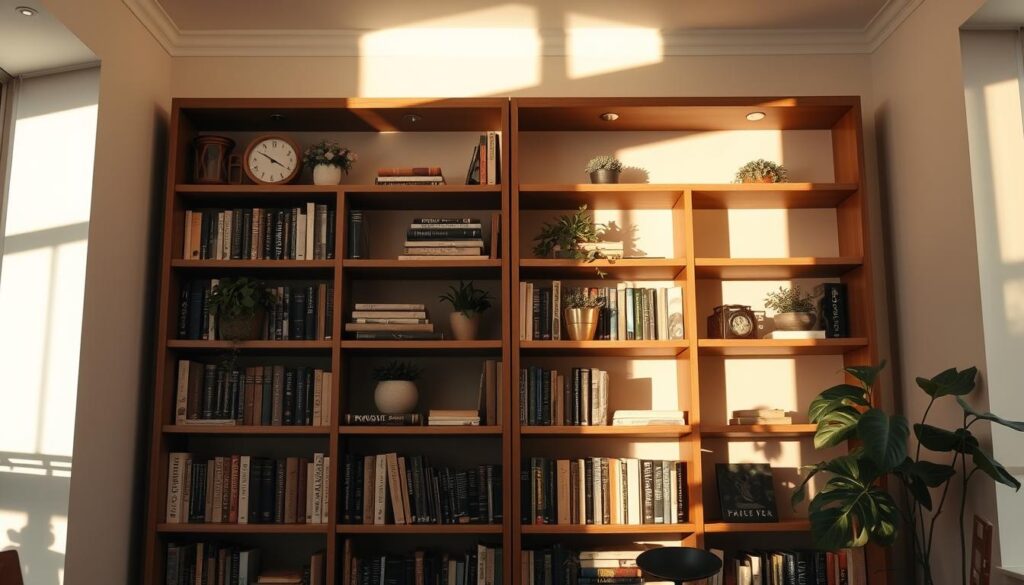
Creating Visual Interest with Spacing and Layering
To add visual interest to your bookshelf, it’s essential to play with spacing and layering. Leaving some space between books and decorative objects can prevent the shelf from looking cluttered. Layering different objects, such as stacking books or placing decorative items in front of or behind books, can also create a more dynamic display.
Incorporating Decorative Objects Among Books
Incorporating decorative objects among your books is a great way to personalize your bookshelf. You can use items like vases, sculptures, or framed photos to add a touch of personality to your bookshelf. When incorporating decorative objects, consider the overall aesthetic you want to achieve and choose items that complement your books and the room’s decor. This approach is part of the creative ways to display books and can enhance your bookish home decor.
By applying these bookshelf styling fundamentals, you can create a beautiful and functional display that showcases your love for reading and adds to your home’s ambiance, potentially inspiring future DIY book decor projects.
Color-Coordinated Book Arrangements
A well-curated bookshelf, arranged by color, can become a stunning focal point in any room. This approach not only adds a decorative element but also creates a visually pleasing display that can enhance the overall aesthetic of your space.
Rainbow Shelves: How to Create and Style Them
Creating a rainbow shelf involves arranging your books in a sequence of colors, typically following the order of the rainbow: red, orange, yellow, green, blue, indigo, and violet. This method can add a playful and vibrant touch to your room.
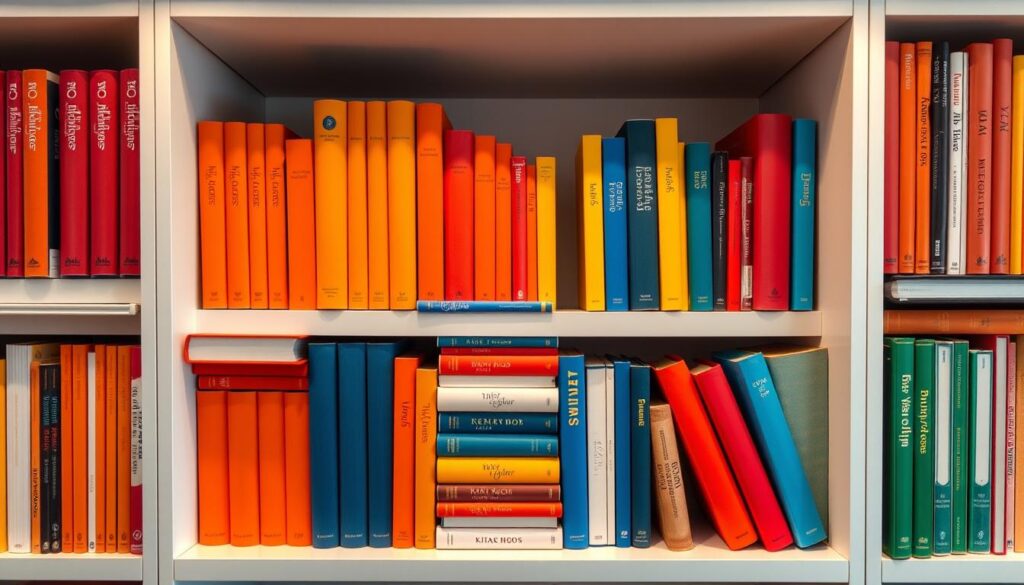
Monochromatic Book Displays for Sophisticated Spaces
For a more subtle and sophisticated look, consider a monochromatic book display. This involves grouping books of the same color together, creating a cohesive and harmonious visual effect.
Integrating Book Spines into Your Room’s Color Scheme
To seamlessly integrate your bookshelves into your room’s decor, consider the color scheme of your room and arrange your books accordingly. This can help create a unified and stylish space.
| Color Scheme | Book Arrangement Tip |
|---|---|
| Monochromatic | Group books of the same color together for a cohesive look. |
| Rainbow | Arrange books in the order of the rainbow for a vibrant display. |
| Neutral | Mix different shades of neutral colors for a subtle, elegant appearance. |
Creating Themed Book Displays
Transform your bookshelves into a narrative-driven space with themed book displays. This approach not only adds a personal touch to your home decor but also creates a visually appealing way to showcase your literary interests.
Seasonal Book Arrangements That Refresh Your Space
One way to create a themed book display is by arranging your books according to seasonal themes. For example, you can group books with winter-themed covers together or display books with summer-inspired titles during the warmer months. This approach keeps your bookshelves fresh and exciting throughout the year.
Genre-Based Displays That Tell a Story
Organizing your books by genre is another effective way to create a themed display. For instance, you can dedicate a shelf to mystery novels or create a section for science fiction books. This not only makes it easier to find specific types of books but also tells a story about your reading preferences.
| Genre | Book Titles | Author |
|---|---|---|
| Mystery | The Murder on the Orient Express | Agatha Christie |
| Science Fiction | Dune | Frank Herbert |
| Romance | Pride and Prejudice | Jane Austen |
Author-Focused Collections as Conversation Starters
Creating a display around a specific author can be a great conversation starter. You can group all the books by that author together, along with some personal items or memorabilia related to the author. This adds a personal touch and can make your bookshelves more interesting.
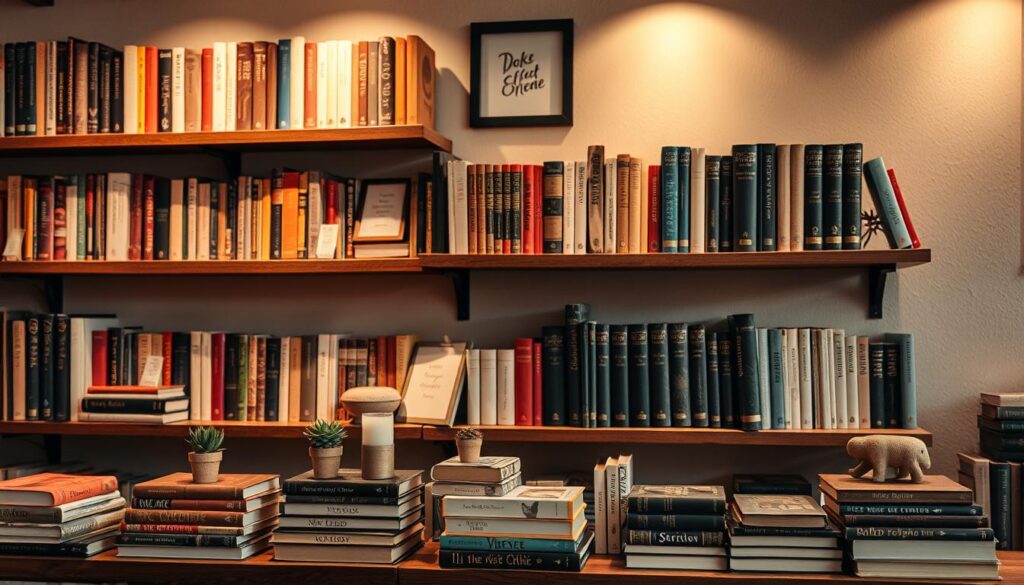
How to Decorate with Books: Tips for Book Lovers in Small Spaces
Even with limited room, you can still create a beautiful and inviting book-filled space. Decorating with books in small areas requires some creativity, but with the right strategies, you can maximize your space and showcase your favorite books.
Vertical Storage Solutions for Limited Square Footage
One of the most effective ways to save space while still displaying your books is by utilizing vertical storage solutions. Tall, narrow bookshelves can fit into tight spaces and make the most of your ceiling height. Consider installing floor-to-ceiling shelves or using tall, freestanding bookcases that can hold a substantial number of books without taking up too much floor space.
Tip: Look for bookcases with adjustable shelves to accommodate books of various sizes, as well as decorative objects you might want to display.
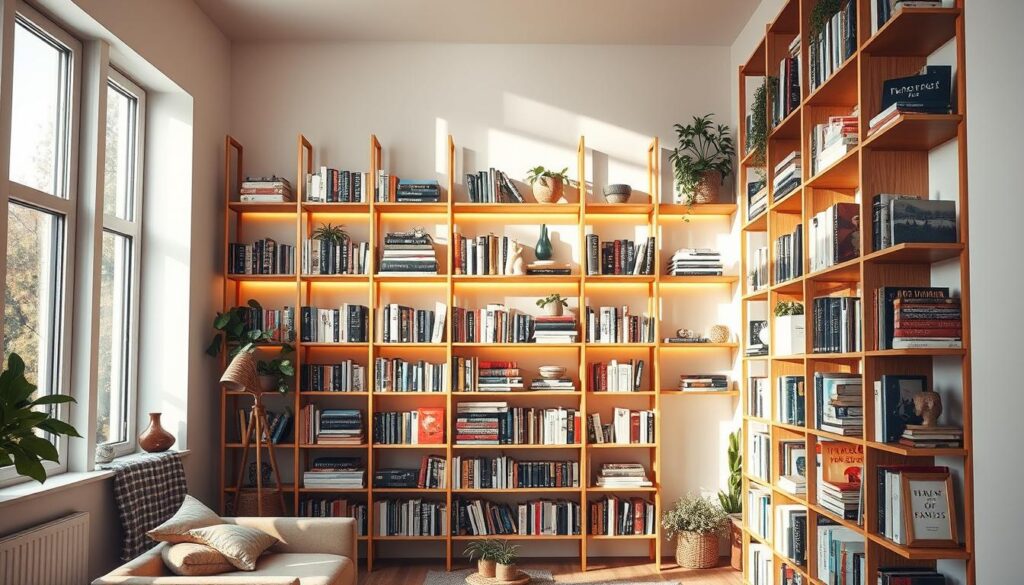
Unexpected Places to Store and Display Books
Thinking outside the box can lead to some innovative book storage ideas. Consider using under-bed storage for out-of-season books or storing them under a window seat with a hinged top. You can also repurpose old trunks, chests, or vintage suitcases to store books, adding a touch of character to your decor.
“The more that you read, the more things you will know. The more that you learn, the more places you’ll go.” – Dr. Seuss
Minimalist Approaches to Book Decor That Maximize Impact
In small spaces, it’s essential to strike a balance between displaying your books and maintaining a clutter-free environment. A minimalist approach can be highly effective. Choose a few statement books or a small collection to display prominently, and store the rest. You can rotate your displayed books seasonally to keep your decor fresh.
| Minimalist Tip | Benefit |
|---|---|
| Select a few statement books | Creates a focal point without clutter |
| Use a monochromatic color scheme | Enhances visual cohesion and sophistication |
| Rotate your book display | Keeps your decor fresh and interesting |
By implementing these strategies, you can enjoy your book collection while maintaining a stylish and uncluttered small space.
Books as Functional Decor Elements
Books are not just for reading; they can also serve as functional decorative elements in your home. By incorporating your book collection into your decor in creative ways, you can add both functionality and style to your space.
Book Stacks as Side Tables and Pedestals
One innovative way to use books as functional decor is by stacking them to create side tables or pedestals. This can be achieved by piling books of varying sizes on top of each other, creating a sturdy base for lamps, decorative objects, or other items.
Using Books as Risers and Platforms for Other Decor
Books can also be used as risers or platforms to elevate other decorative elements. For instance, placing a vase or a sculpture on top of a stack of books can add visual interest and create a unique display.
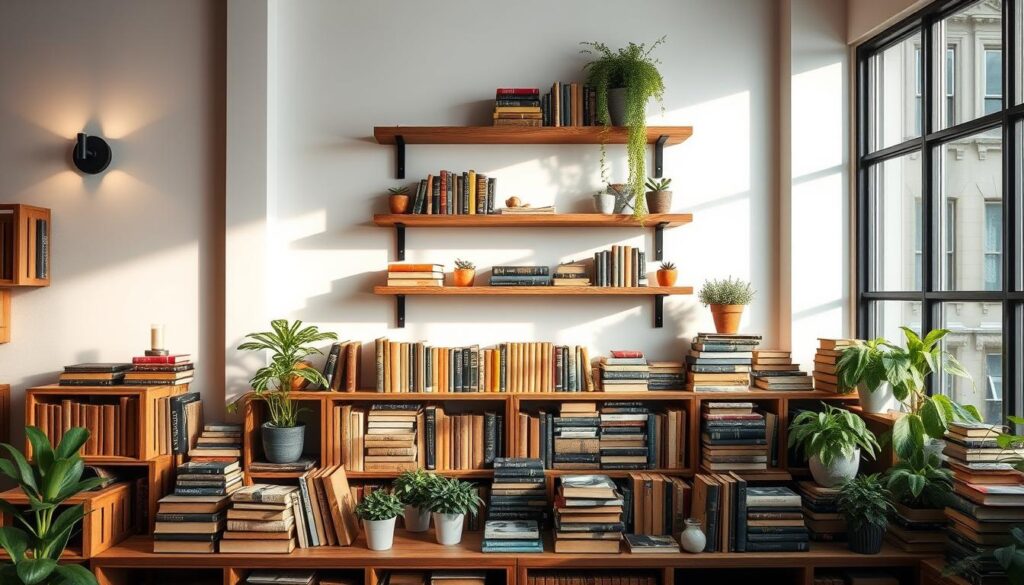
Transforming Books into Wall Art and Installations
Books can be transformed into wall art or installations, adding a literary touch to your walls. This can be done by arranging books in a pattern or design on a wall or by creating a book-themed collage.
| Functional Use | Decorative Benefit |
|---|---|
| Book Stacks as Side Tables | Adds functionality and creates a unique display |
| Books as Risers | Elevates decorative objects, adding visual interest |
| Book Wall Art | Creates a literary-themed focal point in a room |
Styling Open Shelving with Books
When it comes to decorating with books, open shelving is a versatile and stylish option that can be tailored to suit any home decor style. Open shelving allows you to display your favorite books in a way that combines functionality with decorative flair.
The 60/40 Rule: Balancing Books and Decorative Objects
A key principle in styling open shelving is achieving a balance between books and decorative objects. The 60/40 rule suggests that 60% of the shelf should be filled with books, while 40% should be dedicated to decorative items. This balance prevents the shelves from looking too cluttered or too sparse.
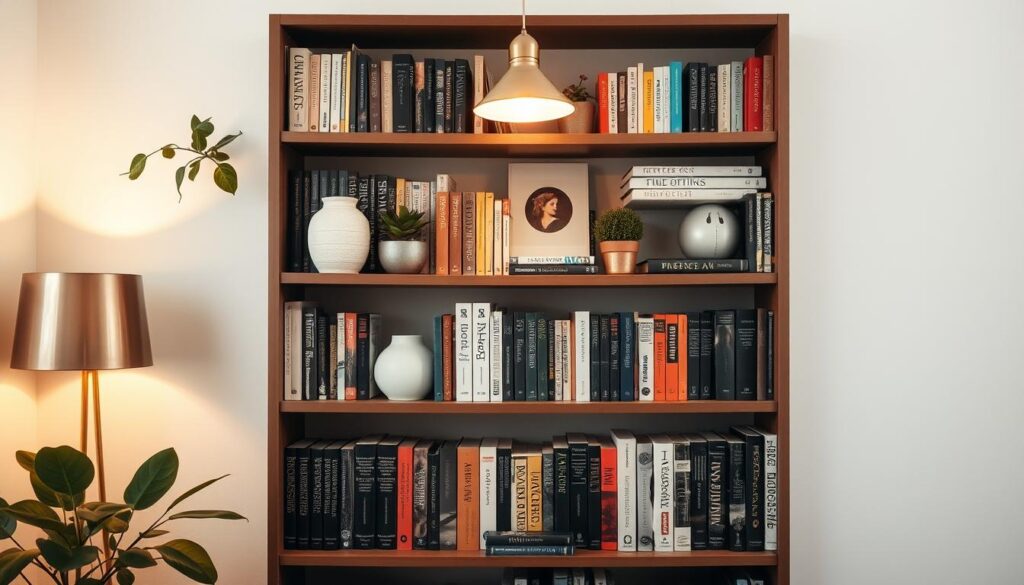
Creating Depth and Dimension on Open Shelves
To add visual interest to your open shelving, consider creating depth and dimension. This can be achieved by layering books of different sizes, stacking some horizontally and others vertically. Incorporating decorative objects of varying heights and textures also adds depth.
Lighting Considerations to Highlight Your Book Displays
Lighting can significantly enhance the appearance of your book displays on open shelving. Consider using LED strip lighting or spotlights to highlight your favorite books or decorative pieces. Proper lighting can create a warm and inviting ambiance, making your book collection a focal point in the room.
By applying these styling tips, you can transform your open shelving into a beautiful display that showcases your love for books and enhances your home decor.
DIY Book Decor Projects for the Creative Book Lover
From book page art to book-themed accessories, there are countless ways to decorate your home with books in a creative and meaningful way. For those who love literature, turning your book collection into decorative elements can add a personal touch to your home.
Book Page Art and Crafts That Preserve Literary Magic
Transforming book pages into art is a beautiful way to preserve the magic of literature. You can create:
- Decoupage furniture with cut-out pages
- Paper flowers to adorn your shelves
- Collages that tell a story
These crafts not only give new life to old books but also add a unique, literary touch to your decor.
Repurposing Damaged Books into Decor Treasures
Don’t discard damaged books; instead, repurpose them into decorative treasures. For instance, you can:
- Use damaged book covers as a base for mixed-media art
- Create a shadow box with torn pages and other memorabilia
- Make a lamp or vase using book pages
This approach not only reduces waste but also adds a creative element to your home.
Creating Book-Themed Accessories for Your Home
Book lovers can find joy in crafting accessories that reflect their passion. Some ideas include:
Book Cover Coasters and Trivets
Use old book covers to create coasters and trivets that protect your furniture while adding a literary flair. Simply decoupage the covers onto ceramic tiles or pieces of wood.
Literary Quote Wall Hangings
Highlight your favorite literary quotes by turning them into wall hangings. You can use stencils, paint, or even print the quotes on paper or canvas, then frame them.
These DIY projects allow you to celebrate your love for books while enhancing your home’s decor. Whether you’re a seasoned crafter or a beginner, there’s a project that suits your skill level and interests.
Literary-Themed Room Designs
With a few simple tweaks, you can turn your home into a bookish haven that celebrates your favorite literary works. Literary-themed decor can transform your space into a cozy retreat that reflects your love for reading.
Cozy Reading Nooks
Creating a cozy reading nook is a great way to showcase your books and create a comfortable reading space. Consider adding a comfortable chair, a floor lamp, and a side table to create the perfect reading haven. You can also incorporate book lover decor tips by displaying your favorite books on a nearby shelf or bookcase.
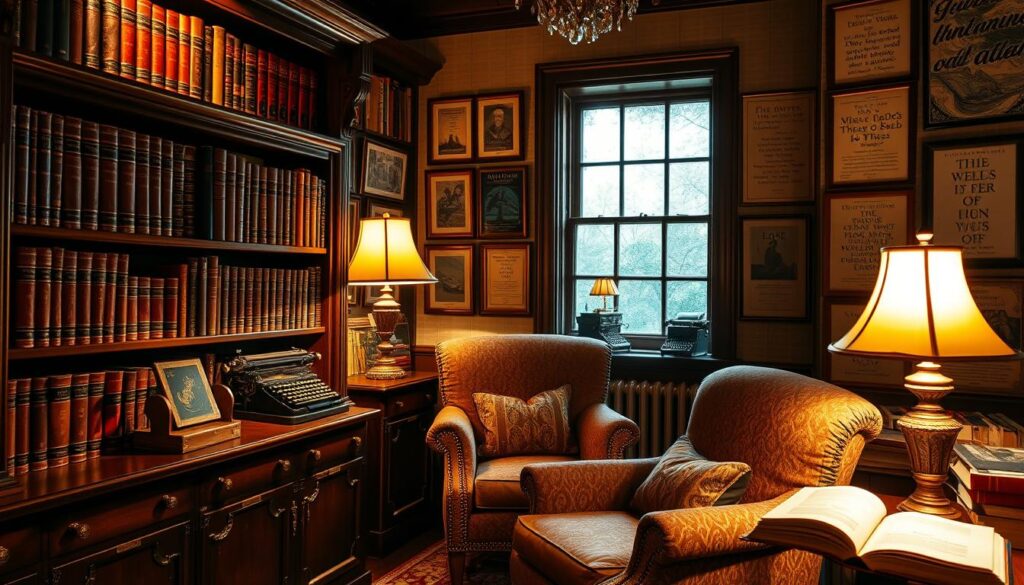
Genre-Inspired Decor
Genre-inspired decor schemes can add a unique touch to your home. For example, a room dedicated to science fiction can feature futuristic decor and book collections. Similarly, a room inspired by romance novels can have a soft, elegant aesthetic. You can also incorporate elements that reflect your favorite literary characters or quotes.
Incorporating Literary Quotes and Art
Incorporating literary quotes and art into your decor can add a personal touch to your space. Consider framing your favorite quotes or displaying literary-inspired artwork. You can also use bookish home decor elements such as book pages, book covers, or author signatures to create a unique and literary-themed space.
By incorporating these elements, you can create a literary-themed room that reflects your love for reading and adds a personal touch to your home.
Conclusion: Celebrating Your Love of Books Through Thoughtful Decor
Decorating with books is a unique way to showcase your personality and love for literature. By applying the tips and ideas presented in this article, you can transform your space into a reflection of your literary tastes.
To get started, consider how to decorate with books in a way that complements your existing decor. You can use book lover decor tips to create a cohesive look that ties together your furniture, color scheme, and personal style.
Styling with books allows you to add a personal touch to your space. Whether you’re a fan of classic novels or contemporary bestsellers, your book collection can be a beautiful addition to your home. Experiment with different arrangements and displays to find the perfect look for your space.
By thoughtfully incorporating books into your decor, you can create a warm and inviting atmosphere that celebrates your love of reading. So, take the time to curate your book collection and let your personality shine through your decor.



